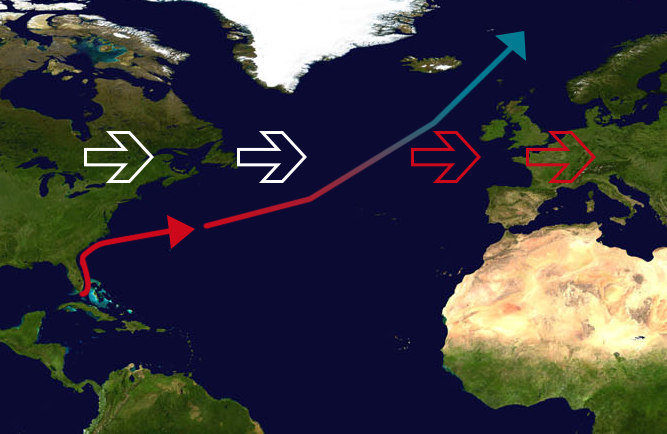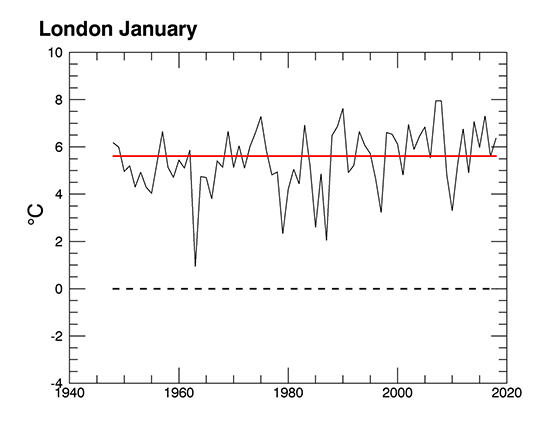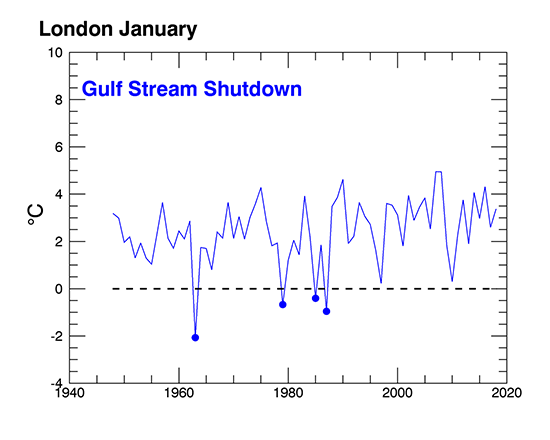Skip this bit if you know it already:
The ‘Gulf Stream’ technically is a component of the broader North Atlantic ocean circulation system. Strictly speaking it is the element of the upper ocean circulation that flows northwards close to Miami before separating from the coast by North Carolina in the U.S. (the first solid red line in the schematic below). Thereafter we have the ‘North Atlantic Drift’ (the red-blue line in the figure below) continuing the movement of surface water northwards. Nonetheless, I think it’s fine to speak of the combined circulation as the ‘Gulf Stream’ for the purposes of easy communication: people generally get what you are referring to. But it is good to know the pedantics – and very important to know so if you ever want to get deep into the scientific calculations (like here. and here. or here).

Anyhow, the surface water going north is salty and warm. The prevailing atmopsheric winds from the west move this heat towards the east, and thus Ireland, U.K. and northern Europe are warmer than they would be if the circulation were to ever break down. Note the cooling of the water as it’s moving north. Ultimately becuase of this heat loss = and its saltiness – it becomes heaveier and sinks beneath the surface to flow south and form the return leg of the system. It is this sinking mechanism which is vulnerable in the face of a warming climate: keep the surface water warm or make it less salty by melting polar ice and you will reduce the vigour of the sinking mechanism and reduce the strength of the whole flow system. Which brings us to… The Day After Tomorrow, which you ought to watch sometime – not for any serious scientific education, but becuase it’s pretty entertaining, and broadly speaking does have some basic element of truth in the ocean bit of the story at least (we’ll address the myths though too : ) ).
Total shutdown. Soon?
In the movie Day After Tomorrow, Jake Gyllenhaal’s dad is buddies with a scientist who detects a total shutdown of the Gulf Stream system. Cue global panic, a night in the museum for Jake, global ice age (we’ll deal with that below) and all sorts of wacky atmospheric monster storm bomb physics. Issue one: is a total shutdown of the system likely before 2100? In all likelihood, no. A total shutdown is not thought likely. But a weakening of the Gulf Stream is very likely, and that weakening may be as much as 50% under the strongest greenhouse gas emission trajectory to the year 2100. (the average weakening according to latest experiments is 34% if greenhouse gas emissions are not abated, and 11% if we decide to act effectively). This theory is not science fiction. The latest, observed, numbers using state-of-the-art global oceanographic techniques indicate that the Gulf Stream already has commenced slowing down. and that the nature of the observed slowdown is commensurate witht he mathematical projections for the coming decades.
It is important to remember that when you read of global warming projections (e.g. the planet will warm by X°C by 2100) that these mathematical projections, include within them, the regional effects of the slowing Gulf Stream: for instance, Northern Europe may be projected to warm by, say, 2°C by 2100 – but that figure of 2°C accounts for the slowing Gulf Stream, which has acted partially to moderate the warming. On the basis of the latest experiments, the regional cooling effects of a partially- slowed Gulf Stream will not reverse the warming due to greenhouse gas emissions
But what if there was a total shutdown sometime? A New Ice Age, yes?
No. Let me repeat: No. Experiments indicate that if – if – there was a total collapse of the Gulf Stream system at some stage (as there has been in the past) that the mean temperature of the planet might decrease to something like 12°C, as opposed to the ~15°C it is currently. In fact, the bulk of this change would be felt in December, January and February and the cooling in Northern Hemisphere summer will be less.
Regional temperature changes will be more severe though. In northern high latitudes – especially around the Arctic where winter sea ice will form in winter, where presently there is open ocean, cooling of up to 14°C might occur, but the experiments also indicate this new sea ice will melt each summer. Around Ireland and the United Kingdom the cooling from the shutdown might be around 3°C, so let’s see what effect that might have. Below is the actual real-world January average temperature for London, from 1948. You can see the 1981-2010 average value in red (about 5.4c) and I’ve marked 0°C with a dashed line.

Let’s see what happens if we remove 3°C from the London time series and create a hypothetical alternate reality in which the Gulf Stream has switched off sometime before 1948. Well, we then get this:

We now see that several of the severe winters that have occurred in the real word (e.g. notorious winters of 1962, 1979 etc) now have average temperatures below freezing point. Whilst the planet has not plunged into the next ice age, this is still serious stuff and there would be significant disruptions, threats and malaise to a country such as the UK. If we consider the chaos that ensued during the Beast of East and imagine that kind of situation persisting for a further two weeks, or worse imagine an entire month with a mean temperature of -2°C, you can begin to get a sense of what we would be dealing with: inordinate energy demands, severely-limited transportation, biology (crops animals..) impacts, in comparison to what we enjoy currently. These implications would be the same for other European countries and cities which currently enjoy the warmth brought by the Gulf Stream.
Remember, please, at this point, again that the probability of a total shutdown is very low: the experiments project that a partial slow down is very likely. And please also remember that the warming projections you hear about already include the cooling effect of the partial slow-down — and that the net warming still wins.
But do keep in mind that the most-up-to-date evidence suggests that the slow down has started. This is not fantasy and it is vital to continue to monitor this incredibly important cog of the global Earth system.

